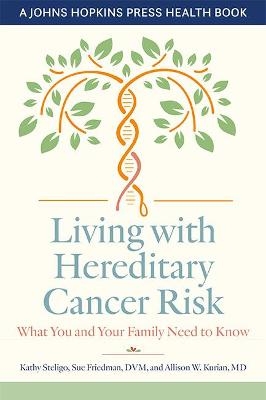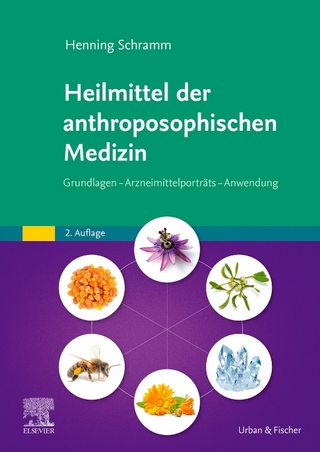
Living with Hereditary Cancer Risk
Johns Hopkins University Press (Verlag)
978-1-4214-4425-3 (ISBN)
Up to 10 percent of cancers are caused by inherited mutations in specific genes. Finding out that you or your loved ones may be at increased risk of developing cancer because of a genetic mutation raises a lot of questions: Is cancer inevitable? Is there anything I should do differently in my life? Will my children also be at higher risk of cancer? Should I have preemptive treatments or surgery? This comprehensive guide provides answers to these questions and more.
Written by three passionate patient advocates, this book is a compilation of the trusted information and support provided for more than two decades by Facing Our Risk of Cancer Empowered (FORCE), the de facto voice of the hereditary cancer community. Combining the latest scientific research with national guidelines, expert advice, and compelling patient stories, the book offers previvors (those who have a mutation but have never been diagnosed), survivors, and their families the guidance they need to face the unique physical and emotional challenges of living in a high-risk body.
An ideal resource for genetic counselors, physicians, nurses, advocates, and others who support and care for the hereditary cancer community, Living with Hereditary Cancer Risk also provides coverage of
• signs of inherited cancer risk in a family;
• the value of genetic counseling and testing;
• mutations in BRCA, Lynch Syndrome, and other genes that elevate cancer risk;
• risk-reducing strategies;
• traditional treatments and newer personalized approaches, including immunotherapies and PARP inhibitors;
• nationally recommended guidelines for prevention, early detection, and treatment;
• insurance coverage and discrimination protections; and
• coping with sexual health, fertility, menopause, and other quality of life issues.
Kathy Steligo (SAN CARLOS, CA) is the author of The Breast Reconstruction Guidebook and the coauthor of Confronting Chronic Pain and The Breast Cancer Book. She is a two-time breast cancer survivor. Sue Friedman, DVM (GULFPORT, FL), the founder and executive director of Facing Our Risk of Cancer Empowered (FORCE), is a breast cancer survivor with a BRCA2 mutation. Allison W. Kurian, MD, MSc (STANFORD, CA) is a clinical oncologist and the director of the Stanford Women's Clinical Cancer Genetics Program.
List of Tables
Foreword, by Matthew Boland Yurgelun, MD
Introduction
Part I. Understanding Cancer and Inherited Risk
1. The Link between Genetics and Cancer
The Basics of Genetics
Gene Wear and Tear and Repair
How Cancers Develop and Grow
Most Cancers Aren't Caused by Inherited Mutations
2. What's Swimming in Your Gene Pool?
Hidden Risk in the Family Tree
Plotting Your Genetic Pedigree
3. Signs of Hereditary Cancer
The Value of Genetic Counseling
Making Decisions about Testing
Insurance Coverage
Privacy and Protection
4. What Your Test Results Tell You
Positive, Negative, Maybe
Making Sense of Statistics
You Have a Mutation; Now What?
Part II. Inherited Gene Mutations and the Cancers They Cause
5. Introducing BRCA1 and BRCA2
Who Inherits a BRCA Mutation?
Signs of a BRCA Mutation
Levels of Risk
6. Lynch Syndrome: Five Genes, One Hereditary Syndrome
Signs of Lynch Syndrome in Families
Levels of Risk
7. Other Genes That Are Linked to Inherited Cancer Risk
Less Known, Less Studied Genes
8. Breast Cancer Basics
Signs and Symptoms
What Affects Breast Cancer Risk?
Types of Breast Cancer
9. Gynecologic Cancers
Ovarian, Fallopian Tube, and Primary Peritoneal Cancers
Endometrial Cancers
10. Gastrointestinal Cancers
Colorectal Cancer
Small Bowel Cancer
Pancreatic Cancer
Stomach Cancer
Anal Cancer
11. Genitourinary Cancers
Prostate Cancer
Bladder, Ureter, and Renal Pelvis Cancers
12. Melanoma
Melanoma of the Skin
Ocular Melanoma
Part III. Strategies for Risk Reduction and Early Detection
13. Risk Management Guidelines
Guidelines for BRCA1 or BRCA2 Gene Mutations
Guidelines for Lynch Syndrome Gene Mutations
Guidelines for Mutations in Other Genes
14. Early Detection Strategies for High-Risk People
The Vocabulary of Screening
Surveillance for Breast Cancer
Surveillance for Gynecologic Cancers
Surveillance for Gastrointestinal Cancers
Surveillance for Prostate and Other Genitourinary Cancers
Surveillance for Melanoma
Screening for Other Hereditary Cancers
15. Medications That Reduce Cancer Risk
Risk-Reducing Medications for Breast Cancer
Risk-Reducing Medications for Gynecologic Cancers
Risk-Reducing Medications for Colorectal Cancers
16. Surgeries That Reduce Breast Cancer Risk
Mastectomy Procedures
Breast Reconstruction Choices
Side Effects, Risks, and Recovery
17. Surgeries That Reduce the Risk of Gynecologic Cancers
Salpingo-Oophorectomy to Reduce the Risk of Ovarian Cancer
Hysterectomy to Reduce the Risk of Endometrial Cancer
18. Surgeries That Reduce the Risk of Gastrointestinal Cancers
Total and Segmental Colectomy to Reduce the Risk of Colon Cancer
Total Gastrectomy to Reduce the Risk of Stomach Cancer
19. Factors That Affect Cancer Risk
Nutrition, Weight, and Physical Activity
Alcohol: An Unwise Choice
Smoking and Tobacco Products
Other Lifestyle and Behavioral Risk Factors
Part IV. Treatment Choices for Hereditary Cancers
20. Identifying Tumor Characteristics That Inform Treatment Choices
Staging and Grading Cancer
Targeted Approaches to Treatment
DNA Damage Repair Genes
21. Treating Breast Cancer
Cancer Type, Subtype, and Stage
Biomarker Testing
Genetic Testing
Options for Treatment
Follow-Up Care
22. Treating Gynecologic Cancers
Options for Ovarian, Fallopian Tube, and Primary Peritoneal Cancers
Options for Endometrial Cancer
23. Treating Gastrointestinal Cancers
Options for Colorectal Cancer
Options for Pancreatic Cancer
Options for Gastric Cancer
24. Treating Genitourinary Cancers
Options for Prostate Cancer
Options for Bladder, Renal Pelvis, and Ureter Cancers
25. Treating Melanoma
Options for Melanoma in the Skin
Options for Ocular Melanoma
Part V. Living with Inherited High Risk
26. Regaining Sexual Health and Intimacy
Body Image
Coping with Pain
Reduced Sexual Desire
Erectile Dysfunction
Rebuilding Intimacy
27. Effects of Prevention and Treatment on Fertility
Preserving Fertility in Women
Preserving Fertility in Men
Other Parenting Alternatives
28. Managing Menopause
Symptoms of Early Menopause
Replacement Hormones
Long-Term Side Effects
29. Side Effects and Other Quality-of-Life Issues
Summarizing Side Effects by Treatment
Managing Immediate Side Effects
Long-Term Effects of Prevention and Treatment
Previvorship, Survivorship, and Follow-Up Care
End-of-Life Issues
30. Making Difficult Decisions
Start at the Beginning: Should You Be Tested?
Decisions about Your Cancer Risk
Decisions about Treatment
Prevention and Treatment Clinical Trials
Decision-Making in 15 Steps
31. You Are Not Alone
Create a Support System
Find Emotional Strength
Pursue Financial Resources
Look to the Horizon
Acknowledgments
Glossary
Notes
Resources
Index
| Erscheinungsdatum | 17.09.2022 |
|---|---|
| Reihe/Serie | A Johns Hopkins Press Health Book |
| Vorwort | Matthew Boland Yurgelun |
| Zusatzinfo | 24 Line drawings, black and white |
| Verlagsort | Baltimore, MD |
| Sprache | englisch |
| Maße | 156 x 235 mm |
| Gewicht | 930 g |
| Themenwelt | Medizin / Pharmazie ► Medizinische Fachgebiete ► Medizinethik |
| Medizin / Pharmazie ► Medizinische Fachgebiete ► Onkologie | |
| ISBN-10 | 1-4214-4425-9 / 1421444259 |
| ISBN-13 | 978-1-4214-4425-3 / 9781421444253 |
| Zustand | Neuware |
| Haben Sie eine Frage zum Produkt? |
aus dem Bereich


